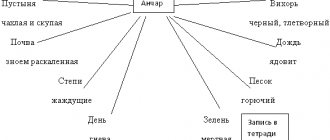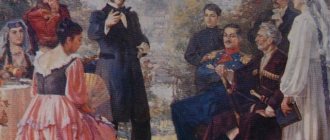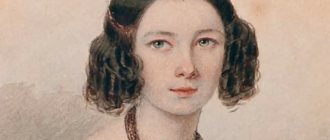Reading the poems of this Russian poet, you realize what true love is: be it love for your native land, love for a beautiful girl, or love for the beauties of the Russian land. He is known as an impressionable lyricist, a master of landscape and a person who understands deep feelings. Sergei Yesenin is a poet whose poems have not lost any reader interest over the course of two centuries. Below is a detailed analysis of one of his most famous poems - “You are mine, Shagane.” Let's try together to understand the intricacies of his work and read between the lines of the author's thoughts and experiences.
1. History of creation
Yesenin appreciated and respected the culture of the East. His dream was to see Persia, which he imagined as the land of poetry, the homeland of Saadi, Ferdowsi, Rumi, Hafez.
He was not able to see fabulous Persia, but the poet visited Georgia and Azerbaijan, the beauty of which inspired him with the poetic cycle “Persian Motifs”.
The poem “You are my Shagane, Shagane...”, which became the heart of the cycle, was written in 1924 in the Caucasus.
From the first days of his stay in Batumi, Yesenin met the local teacher Shagane Nersesovna Talyan. The girl was charming, smart, well-read - they struck up a friendship.
After a short time, Yesenin handed Shagane poems dedicated to her, which greatly confused and surprised her Batumi acquaintance. The image of Shagane is covered with tenderness and gratitude, because in this girl the poet found what he always looked for and rarely found in women: spiritual purity, simplicity, dignity.
LiveInternetLiveInternet
Sergei Alexandrovich Yesenin
Shagane, you are mine, Shagane! Because I’m from the north, or something, I’m ready to tell you about the field, About the wavy rye under the moon. Shagane, you are mine, Shagane.
Because I’m from the north, or something, Because the moon there is a hundred times bigger, No matter how beautiful Shiraz is, It’s no better than the expanses of Ryazan. Because I'm from the north, or something.
I'm ready to tell you about the field, I took this hair from the rye, if you want, tie it on your finger - I don't feel any pain. I'm ready to tell you the field.
About the wavy rye under the moon You can guess by my curls. Darling, joke, smile, Just don’t wake up the memory in me About the wavy rye under the moon.
Shagane, you are mine, Shagane! There, in the north, there’s a girl too, She looks terribly like you, Maybe she’s thinking about me... You’re mine, Shagane.
Shagane Talyan
The poet Sergei Yesenin dreamed all his life of visiting distant Persia, the image of which, gleaned from fairy tales, excited his imagination. His dream, alas, was never destined to come true, but in 1924 Yesenin visited the Caucasus, thanks to which a very romantic and sensual poetic cycle “Persian Motives” was born.
Sergei Yesenin (center) in the Caucasus
One of the key poems included in this collection was the work “You are my Shagane, Shagane...”. His heroine is not a fictional character, but an ordinary school teacher Shagane Talyan, whom the poet met in Batumi and was literally smitten by her dazzling oriental beauty.
It was this Armenian girl who became the heroine of a number of poems that were included in the “Persian Motifs” cycle. She had very warm friendly relations with the poet, so in her memoirs, Shagane Talyan says that she was very surprised when, on the third day after they met, Sergei Yesenin dedicated her famous poem “Shagane, you are mine, Shagane...” and handed her a collection of his works with a dedicatory inscription .
Yesenin’s friendship with a school teacher from Baku helped the poet not only learn the character and worldview of Eastern women, but also provided rich food for his creative imagination. Therefore, the poem “You are my Shagane, Shagane...” is written in the form of a love letter, in which the author not only confesses his feelings to the main character, who is the prototype of all Eastern women, but also tells her about himself, his thoughts and desires . This work is built on the bright contrast of the North and the East, which the author very subtly and skillfully uses to draw a line between the two worlds and show their differences. Admiring the Caucasus and his beloved Persia, Sergei Yesenin realizes that eastern countries attract him with their mystery, fabulousness and unpredictability. However, as soon as he plunges into the unfamiliar world that the poet dreamed of in his sleep and in reality, he begins to feel a sense of longing for home, so distant and infinitely dear.
Therefore, addressing Shagane in his poem, Sergei Yesenin wants to tell her about his homeland. Emphasizing that he comes from the North, the author does not bother himself with describing the sights of the East, believing that his true pearl is the timid and shy Shagane. However, the poet does not spare colors to tell what his native side is like , because “the moon is a hundred times larger there,” and the “wavy rye” resembles the color of his hair. As a refrain in the poem “You are my Shagane, Shagane...” the phrase “I will tell you the field” sounds, which is deliberately constructed with an error, but at the same time is very consonant with the expression “I will open your soul.” Thus, the poet seems to be hinting that his Slavic soul is as wide and vast as a Russian field, and as generous as the land that gives a rich harvest.
With all his admiration for the East, Sergei Yesenin Fr. But, being far from home, the poet asks Shagane not to disturb his memory with memories that cause pain. In the finale, the author admits that there, in the north, there is also a girl who is surprisingly similar to Shagane and, perhaps, at this moment is thinking about the poet. This unexpected thought fills his heart with tenderness and warmth, which is addressed to the oriental beauty. Nevertheless, the poem, filled with a sharp and some kind of painful love for Russia, helps Sergei Yesenin dispel the myth of the mysterious East . The poet satisfied his curiosity, and now dreams of returning home, preserving memories of the beauty of oriental women and the fabulous charm of the Caucasus.
Text: pishi-stihi.ru
Image system
The images of the poem are contrasting. North and south are opposed to each other:
- Shagane has a double - a girl “in the north”,
- Shiraz roses cannot compare with rye under the moon,
- and “no matter how beautiful Shiraz is, it is no better than the expanses of Ryazan.”
The hyperbole “the moon is a hundred times larger there” testifies to the strength of the poet’s attachment to the “Ryazan expanse.”
The hero also asks the girl to joke, smile, but not “awaken the memory” of her homeland. Her beauty only briefly distracts him from thoughts about those who remained in Russia, and these thoughts cause him pain.
Everything about Armenia
Shaandukht (Shagane) Ambartsumyan was born in 1900 in Akhaltsikhe (Georgia) into a family of teachers. For Nerses Ambartsumyan and Maria Karakashyan, the girl was a long-awaited child; she was born when they were already over 30. Shagane lost her parents early (due to the consequences of typhus), the girl lost her mother at 11, and her father at 19 years old. Her uncle took her to his place in Batumi and gave her a good education. She graduated from the women's gymnasium in Khashuri, and a year later began teaching at the Armenian school in Tiflis. Among the teachers, Shagane was distinguished by her extraordinary appearance: snow-white skin, light brown hair and big eyes - more than once broke men’s hearts.
In 1921, having won the heart of Tiflis economist Stepan Terteryan, Shagane got married, and a year later gave birth to a son, Ruben (he is a candidate of medical sciences). However, they never managed to live a happy life: Terteryan died at the age of 36 due to lung disease. In 1923, Shagane moved to her cousins in Batumi and continued her teaching career. Note that in addition to teaching, she was very fond of poetry and often went to literary cafes to listen to poems by her favorite poets.
“I lived for these meetings. These evenings brought me special joy,” Shagane told Don magazine in 1964.
In 1924-1925, the Russian poet Sergei Yesenin stayed in Batumi. At that time, it was fashionable to invite poets to their homes for poetry evenings. And the house of the Shagane sisters was no exception. After a meeting between the poet and the young teacher, Yesenin began work on a poem for the collection “Persian Motives” - “You are mine, Shagane.” Impressed by the beauty of the Armenian girl, the poet described her in the form of a young Persian woman Shagane from Shiraz. Over time, this collection was loved by many; among the most memorable poems was “Shagane”. Here's how the lines of the famous poem came about:
“Leaving school, I again saw the poet on the same corner. It was cloudy and there was a storm at sea. We said hello, Sergei Alexandrovich suggested we walk along the boulevard, saying that he did not like such weather and would rather read poetry to me. He read “You are my Shagane, Shagane...” and immediately gave me two sheets of checkered notebook paper, on which was written a poem and the signature: “S. Yesenin,” she recalled.
It is known from sources that the poet was shocked by the charm of the young teacher and began to court her. In one of his letters, Shagane talks about one of these meetings:
“Sergei Alexandrovich loved to come in the evenings and drink tea with tangerine jam, which he really liked. When I sent him to write poetry, he said that he had already worked enough, and now he was resting. Once I got sick and for three days Yesenin came to visit, prepared tea, talked with me, read poems from the “Anthology of Armenian Poetry”. I don’t remember the content of these conversations, but it can be noted that they were simple and calm.”
Yesenin read his works to her, took books from her home library and talked to her about the merits of Persian poetry. After living in Batumi for several years, the poet returned to Petrograd, and our heroine left for Tiflis, where she continued to work at school.
“On the eve of his departure, Sergei Alexandrovich came to us and announced that he was leaving. He said he would never forget me. He said goodbye to me, but did not want me and my sister to accompany him. I also did not receive any letters from him. Sergei Alexandrovich exists, and until the end of my days he will be a bright memory of my life.”
Little is known about how her life developed later. In 1930, Shagane married for the second time, to composer Vardges Talyan. And after moving to Yerevan, Shagane no longer worked. She took care of household chores and raising her son, living a full 76 years.
Shagane, you are mine, Shagane! Because I’m from the north, or something, I’m ready to tell you about the field, About the wavy rye under the moon. Shagane, you are mine, Shagane.
Because I’m from the north, or something, Because the moon there is a hundred times bigger, No matter how beautiful Shiraz is, It’s no better than the expanses of Ryazan. Because I'm from the north, or something.
I'm ready to tell you about the field, I took this hair from the rye, if you want, tie it on your finger - I don't feel any pain. I'm ready to tell you the field.
About the wavy rye under the moon You can guess by my curls. Darling, joke, smile, Just don’t wake up the memory in me About the wavy rye under the moon.
Shagane, you are mine, Shagane! There, in the north, there’s a girl too, She looks terribly like you, Maybe she’s thinking about me... You’re mine, Shagane.
Central characters
The central characters of the poem:
- Shagane,
- lyrical hero
- and the girl "in the north".
The poet looks into Shagane’s face and, as in a mirror, sees in her an unforgettable image of the past.
Among Yesenin scholars there is no clear opinion as to which girl Shagane Talyan reminded Yesenin. At that time, he actively corresponded with Galina Benislavskaya, which served as a reason to compare her with the Georgian beauty.
However, a more convincing hypothesis is that the northern girl is Zinaida Nikolaevna Reich, the poet’s ex-wife, the mother of his children Yuri and Tatyana. By the time the poem was written, Zinaida Nikolaevna was already in another marriage, but Yesenin still treated her with respectful tenderness and respect. The photographic resemblance between Z. Reich and Shagane is truly striking.
Composition
The composition of the work is circular.
Beginning and ending the work with an appeal to Shagane, the poet tries to focus on the moment of the present, but his memory keeps bringing him back to the past.
development of action , since the hero’s thoughts revolve in the same orbit of love memories.
The climax of the poem is the last stanza of the poem which mentions the girl in the north.
Analysis of the poem “Shagane, you are mine, Shagane...” by Yesenin
The poem “Shagane, you are mine, Shagane...” by Sergei Aleksandrovich Yesenin belongs to the series of works “Persian Motifs”. Shagane is a non-fictional character. This is a real Armenian girl from the city of Batumi, where the poet had the pleasure of meeting her. Many poems included in the collection dedicated to the East were dedicated to the girl, the poem “Shagane, you are mine, Shagane...” one of the first. The poet and the girl were good and warm friends, not falling in love, but only admiring each other, they learned a lot of new things about their native land.
Sergei Alexandrovich Yesenin, with the help of a poem, tells the girl about his northern region, about the beauty of his native nature. In the poem, the author conveys his feeling and mood that no matter how beautiful her land is, he would never exchange it for his native space, endless fields and golden rye. S.A. Yesenin, in the poem that he gave to the girl, Shagane, explains how beautiful his big homeland is and how dear it is to his heart. The poet wants to convey his strongest feelings for his homeland, starting and ending the quatrains with the same phrase, as if justifying to the girl that he is from the North.
Does your teacher check for plagiarism? Order a unique work from us for 250 rubles
Connect with us:
“...I took this hair from the rye, if you want to tie it on your finger... you can guess by my curls...”
- with these images the poet makes it clear that every cell of his soul and every part of his body belongs to his northern homeland. And his hair is as light as rye and his soul is like an open and large field. Playfully, the author encourages the girl to enjoy his appearance, the appearance seems to reflect the beauty of Russian nature, the Russian golden land, rich in landscape colors and fresh air of vast territories.
The poet asks Shagane not to remind him of his native land; he calls on the girl about this in his lines of the work. Sergei Alexandrovich himself is greatly disturbed by memories of his homeland; he misses his native land and Russian landscapes. Talking about his northern region, the poet awakens in himself memory and longing. He is sad for the landscapes dear to his heart, the wide fields and golden rye. So painful S.A. Yesenin talks in the poem about Russian nature, many times mentioning his most favorite and memorable features and moments about the Russian land in his soul, that it seems that now he is ready to run away there without looking back.
From the last lines of the poem we learn that S.A. Yesenin does not at all hide from Shagane that he already has love in his native land. And his beloved is waiting for him and, as the poet himself hopes, remembers him often. Not every girl will like the comparison of her beauty with someone else’s, but the poet boldly admits to his friend that her beauty is certainly beautiful, but his love and heart belong not only to his homeland, but he is also devoted to a girl who is as good as Shagane. The poet is sad and yearns not only for his native land, but also for his beloved.
The poet did not skimp on the use of visual means in order to talk with bitterness in his heart about his strong feelings for his native nature. Many times the author uses the same phrases and words in order to convey to the reader and the girl to whom this poem is dedicated how much homesickness takes him away from memories, how much he wants to return to his native lands. He uses epithets, personification and metaphors in his poem.
Thus, the poem “Shagane, you are mine, Shagane...” is dedicated not so much to a Caucasian girl from Batumi, but to his beloved native land, from which the poet will never be able to turn away, and his desire to return, no matter where he is, will always be just as strong and devoted.
Size, rhyme, stanza
The poem is written in trimeter anapest with alternating male and female rhymes.
The poem has 5 five-line lines, connected by a special rhyme scheme: the first five-line line is repeated line by line in all subsequent five lines. Moreover, each line is repeated in the first and last line of each five-line.
This is how a wreath of flowers is woven, one row is attached to the other, holding the previous ones and giving a run to the next ones. This “weaving” is typical for a rondo.
Means of artistic expression
The poem uses the following tropes:
- epithet: “wavy rye”;
- metaphor: “you can guess about the wavy rye under the moon by my curls”;
- metonymy: “I’m ready to tell you the field”, “I took this hair from the rye”;
- hyperbole: “the moon is a hundred times bigger there.”
The poem is built on an antithesis: Shiraz is the expanse of Ryazan, Shagane is a girl from the north.
Alliterations (“sh”, “s”, “x”) convey the tenderness and sincerity of Yesenin’s confession, reminiscent of a whisper.
Assonances (“a”, “e” at the beginning and “o”, “u” at the end) help to see how the poet’s mood changes when he remembers his homeland and begins to yearn for it.
Brief analysis of the work
“You are my Shagane, Shagane!” - a real pearl of the “Persian Motifs” cycle, created following the results of Yesenin’s trip to the Caucasus.
- History of creation - the work was written in 1924 during Yesenin’s stay in the Caucasus, the poet included it in the “Persian Motifs” cycle.
- The theme of the poem is sympathy for a woman, love for the Motherland.
- Composition - The poem is a monologue-address to Shagane, which can be divided into two parts: tender words addressed to Shagane and memories of the Motherland. Formally, the poem consists of five five lines. The peculiarity of its form is the repetition of key lines framing the stanzas.
- Genre: love letter.
- The poetic meter is a trimeter anapaest, the rhyme is circular ABBA and parallel AABB.
- Metaphors - “I’m ready to tell you the field”, “I took this hair from the rye”, “just don’t awaken the memory in me.”
- Epithets – “beautiful Shiraz”, “wavy rye”.
The lyrical monologue addressed to the beautiful Shagana is made in the traditions of oriental poetry. The intricate design of the stitches evokes associations with the exquisite interweaving of the patterns of a Persian carpet.
My attitude
The poem “You are my Shagane, Shagane...” seemed to me beautiful, mysterious and romantic.
At first I was happy for the heroine of the work, because the poet addresses her with deep tenderness. But then I felt sad that he actually loves someone else and, looking at Shagane, actually remembers his compatriot.
It turns out that the poet is unhappy, because what is most dear to him remains in his homeland. And the one who is unhappy himself cannot truly warm the one who is nearby.








